To capture the most beautiful and “natural” images, photographers often do not hesitate to disrupt the natural habitats of birds.
On June 23, 2021, a photographer uploaded images of a Black-crowned Oriole (Oriolus chinensis) nest in Binh Son, Hebei Province, China, to Weibo. The photos feature two orioles with unusual appearances, boasting yellow bodies but black wings and tails, along with a black ring around their eyes. They stand proudly in the nest, surrounded by chicks stretching their necks, waiting to be fed.
Overall, it was a beautiful photo. The lighting was so perfect that an amateur photographer could easily showcase their skills.
The problem is, it was too perfect.
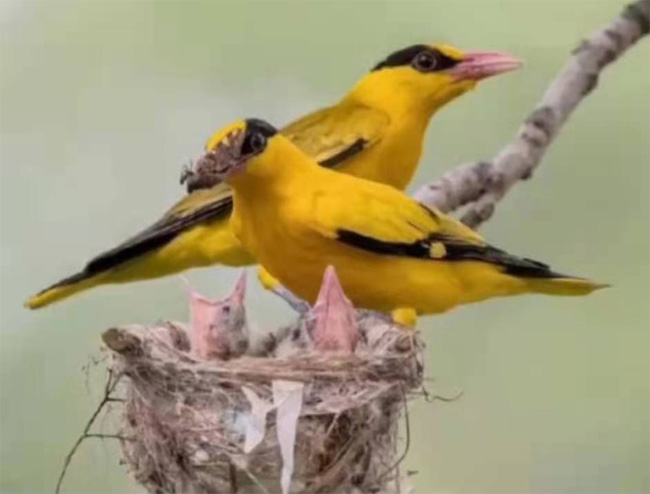
Photo uploaded on Weibo.
In the same post, the photographer jokingly mentioned that he had meticulously trimmed the nest to resemble a spoon. In a video posted on Douyin (the Chinese version of TikTok), it was evident that he had indeed done so with another bird’s nest – that of the Paradise Flycatcher (Terpsiphone incei).
In fact, trimming the nest and surrounding foliage not only “helps” the nest appear clearer through the camera lens but also exposes it to sunlight and the eyes of predators. Ironically, the iconic images captured by photographers can lead to the birds’ untimely deaths.
This reality was confirmed three days later when a wildlife conservation blogger posted a photo of the same nest. At least one chick had died, and the parent birds had abandoned the carcass. The post garnered tens of thousands of shares, sparking outrage over speculations that the chick died due to prolonged exposure to sunlight.
However, this is not an isolated incident. Such occurrences have been happening for a long time, according to nature lovers and veteran photographers in China.
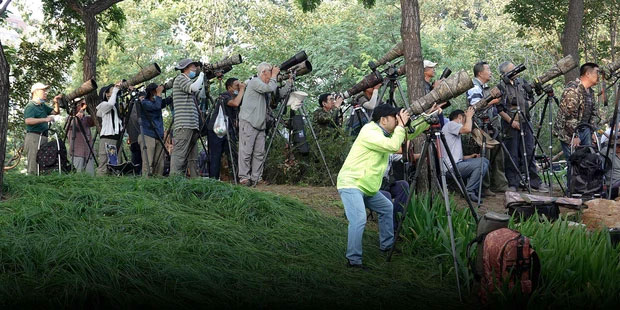
Photographers flocking to capture birds.
In May 2017, in Nanhui Park (Shanghai), the vegetation surrounding a bird’s nest was completely cleared, and no birds remained there. In April 2020, a photographer trimmed the branches around a nest of a Red-breasted Flycatcher (Pericrocotus ethologus) in Heihong Lake Park (Kunming), leading to the death of all the chicks in the nest due to rain a few days later.
And it’s not just about disturbing nests. In recent years, wires and fishing lines hidden in bait have caused countless birds to die. They trap birds for footage from vehicles, exhausting them in the process. Others perish after being captured and taken to studios for photos.
Birdnet – a community of bird enthusiasts in China, always prioritizes the “natural state” of birds above all else. Yet, a prominent activist within this community continues to post “staged” photos, receiving much support.
The Dark Truth Behind Masterpieces
In July 2021, a pair of diving birds built a nest on lotus leaves at the Guo Yuan Lake (Beijing). However, this year, the lotus plants in the lake did not grow as tall as usual, making the nest more visible to passersby.
“Diving birds are highly responsible: when building a nest, both the male and female work tirelessly to clear the area. Once the nest is complete, one sits on the eggs while the other forages,” said a photographer living near the lake.
The tiny birds actually built their nest when the small lotus flowers were just beginning to bloom. But then tragedy struck. Two nests containing a total of seven eggs were destroyed by rain. When the third nest was built and new eggs were laid, it was submerged by waves from four speeding boats.
Yan – a professional photographer who witnessed it all, stated, “The female bird circled the nest, watching her chicks sink to the bottom of the lake.”
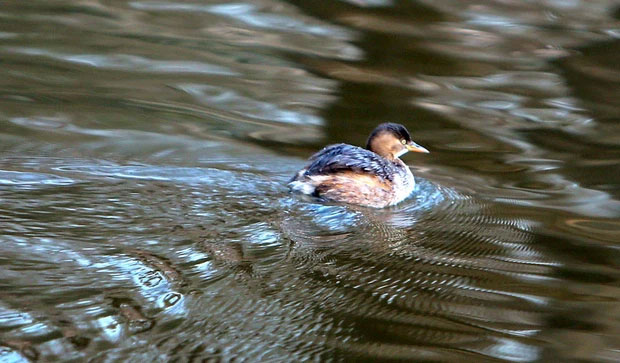
Photo taken in Handan, Hebei.
Thus, the pair had to start over, building a fourth nest on a lotus leaf close to the shore. However, before it was completed, the female had to lay eggs on another leaf. “She couldn’t wait any longer,” Yan remarked.
In the following days, Yan carefully observed the pair of birds every morning. The last time was on July 12, during a heavy storm. With an umbrella tucked under his arm, he captured images of the pair desperately trying to protect their eggs in torrential rain. He patiently awaited to satisfy his curiosity about the fate of the birds and their nest.
But not every photographer possesses the dedication and ethics of Yan. The number of birds that die or are injured due to the actions of individuals like him is countless. This was evident in the story told by Sen Lin, a bird lover since the 1980s.

A photographer capturing a pair of birds at Guo Yuan Lake.
Five years ago, a pair of Japanese Robins (Larvivora akahige) were spotted at the Temple of Heaven (Beijing). This migratory species, belonging to the sparrow family, rarely appears in the city. Yet, just a few days later, someone had a close-up photo of the pair, which clearly showed a fishing hook protruding from its throat, indicating that the bird had swallowed it while eating bait from that photographer.
And no one knows what happened to that pair of birds afterward.
Out of Sight, Out of Mind
While the photographer capturing the Black-crowned Oriole nest in Binh Son openly joked about trimming the nest, many others deny their actions.
In Guo Yuan Lake Park, another photographer recounted seeing a photo in a chat group of a nest with several eggs inside, devoid of any surrounding foliage, taken directly from above.
Suspecting that the photographer had disturbed the nest, she wrote a message in the group asking how the photographer achieved that shot. But despite her repeated inquiries, there was no response.
Another incident occurred at Laoshan Amusement Park, just 10 km from Guo Yuan Lake. Cai, a bird enthusiast, was photographing a European Scops Owl (Otus scops) perched on a walnut tree. In the photo, three owls all looked toward the lens, their eyes wide open and alert.

Photographers gather when a rare bird species appears.
Cai was not the only one paying attention to the owls. Whenever a rare bird species appears, the birdwatching community quickly becomes aware. After that, it’s just a matter of time before the camera lenses start to “fly” in.
“The owls only need to make the slightest movement, even just opening their eyes, and the sound of shutter clicks immediately follows,” reported on July 8. That night, someone even shone a flashlight directly into the owls’ faces to take pictures until park security intervened.
For nocturnal birds like owls, daytime is their time to rest. Yet, in every photo, their eyes are wide open, giving the lens a somewhat intimidating gaze. But Cai prefers to interpret that look as a stroke of luck for his career, without a thought to the disturbance he has caused.
According to Yan, using bait to lure birds is not necessarily negative, and he believes he holds a higher standard in this regard. “If I have to set a trap, I would use naturally available food so that the behavior of the birds is not affected. You can’t generalize this community based on a few extreme cases.”
Yan may be right, but not every photographer has the experience and professionalism, nor do they travel as far as he does. Many are amateurs, operating close to where they live, sharing their work with the community through chat groups or forums.
They post images to gain recognition from fellow enthusiasts. As Li Qiang, a former president of a birdwatching association, noted, their common goal when holding a camera is to capture “beautiful close-up photos, unobscured by foliage of the birds.”
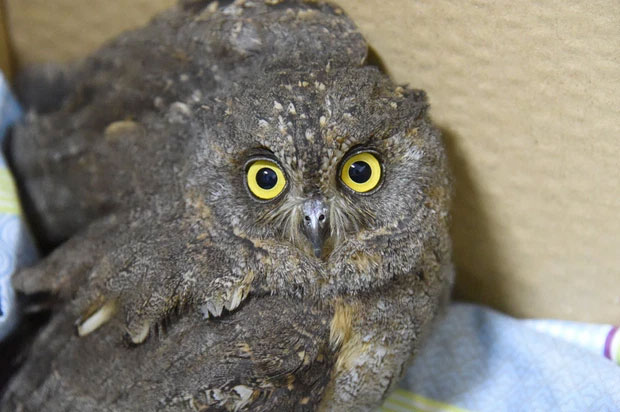
All three owls look toward the lens, their eyes wide open and alert.
And not all amateur photographers are the ones disturbing the birds. They simply benefit after someone else has done it first. “But just a few are enough to cause a stir,” Sen Lin remarked.
Active around the Temple of Heaven, Sen has witnessed many unpleasant incidents over the years. He has seen people crowding around a flock of owls or blocking the path to a kingfisher’s nest to prevent them from escaping the lens.
Every time he tried to intervene, he was met with anger. “I take photos for fun, and I will do whatever I want to enjoy myself,” is the typical response he received. And no one helped him either. “They think, ‘Someone has gone out of their way to make me happy without any effort on my part. So why should I stop them?'” he shared further.
Additionally, there is the issue of littering, which is something Sen Lin finds most bothersome. “Whenever there are more than five people taking pictures, there are immediately cigarette butts scattered everywhere. If not, there are trash bags, plastic bottles, a lot of waste,” Sen shared. He recalled one time he collected 400 cigarette butts within an area of less than 20 meters in radius. On another occasion, he gathered four bags containing nearly 100 kilograms of trash after a photo event in the outskirts of Beijing.
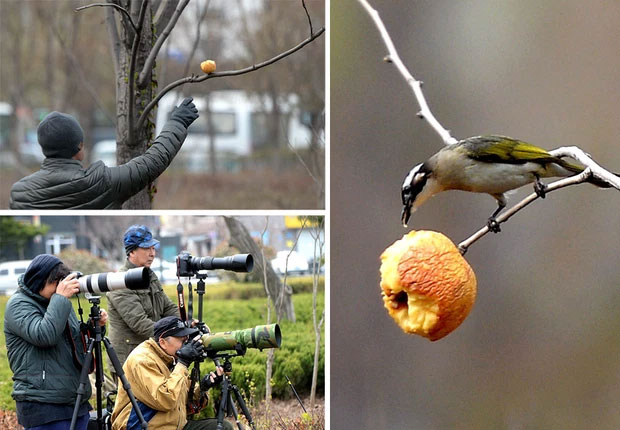
Setting traps to attract birds.
During that same occasion, he found a European owl dead from exhaustion after being relentlessly chased by photographers trying to capture its flight.
Frustrated, Sen left the community four years ago. He has not taken any bird photos since then.
Ethical Standards
Guan Xiangyu, the executive director of the China Birdwatching Association, emphasized that there are some unwritten rules in this field. Among them, the most important is to maintain a distance when observing or photographing birds to avoid alarming them due to human presence.
However, this regulation is quite complex. The safe distance depends on various factors, including the time of day, the season, and the specific bird species. Even within the same species, each individual can behave differently.
Gathering to take photos can make adult birds hesitant to feed their young, while disturbances to nests can put them at risk of early death—both from natural disasters and predation. Even crows and hawks—species that are not typically predators—occasionally steal eggs or attack chicks if the opportunity is too clear.

A bird’s nest cleared for photography.
In early 2021, after learning that a pair of great bustards (Otis tarda) had appeared in Tongzhou (Beijing), photographers immediately flooded the area. Every day, dozens of cars parked near the field where the couple nested, bringing cameras and tripods. They surrounded the nest, sometimes trying to scare the birds into flying up to capture memorable shots.
Later, some people noticed that the male bird had a bleeding chest. Although it was unclear how it got injured, this did not deter thoughtless photographers from driving the two birds into the adjacent wheat field.
The problem is that in China, regulations regarding bird photography are slow to reform. In June 2020, a nature protection law came into effect, prohibiting actions such as “disturbing, harassing, feeding, trapping (for photography purposes), making loud noises, shining lights, or any action that may disrupt the lives and reproductive capabilities of wildlife.”
Other regions, such as Xiangfan (Hubei), Taiyuan (Shanxi), and Chifeng (Inner Mongolia), have also established specific regulations for bird photography, especially during the breeding season.
At the end of May 2020, many photographers intentionally set traps with sharp wires in flower gardens in Beijing. It became serious enough for garden security to issue a warning: “Using insects to lure birds is strictly prohibited. We will report to the police and local forestry authorities if violations occur.”
Since then, such incidents have decreased significantly, but fundamentally, most people in the community remain dissatisfied, claiming that the regulations hinder their creativity and art.
“All those photos of birds feeding their chicks in the nest need to be trimmed beforehand. If not, how can we take the pictures? How can we make a living? Let people enjoy themselves. After all, humans are still selfish creatures,” a photographer candidly wrote on Weibo.


















































